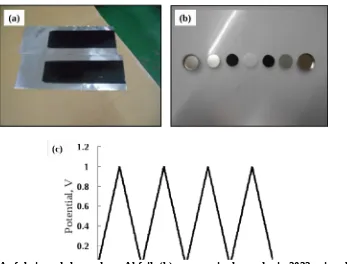Malaysian Technical Universities Conference on Engineering & Technology (MUCET) 2013
Electrode Fabrication and Electrochemical Analysis of Carbon Based
Electrochemical Capacitor in 1M H2SO4 Electrolyte
Mohd Asyadi Azama *, M. A. Azizana, N. S. A. Manafa, R. Izamshaha, and N. Mohamada
a
Faculty of Manufacturing Engineering, Universiti Teknikal Malaysia Melaka, Hang Tuah Jaya,
76100 Durian Tunggal, Melaka, MALAYSIA. energy storage devices becomes crucial. It is a fact that batteries cannot be used in high power application due to low power density and the life cycle also short due to electrode material degradation during charging and discharging process [Azam, 2012]. Here, the world is now focusing on the advancement of electrochemical capacitors (ECs) or supercapacitors as one of the best energy storage device ever. In addition carbon materials have played important roles for generation and storage of energy in different forms, such as charcoals for heat source since prehistoric age, cokes for melting and reducing natural ores for production of various metals, graphite moderators of atomic reactors for power plant and graphite anodes for lithium ion rechargeable batteries [Inagaki, 2010]. Recent development in science and engineering on carbon materials made us possible to prepare porous carbons, not only microporous but also mesoporous carbons in different structures, textures and morphologies via various processes. Many of porous carbons developed recently cannot be classified into activated carbons (ACs), mainly because no activation process is included.
In this article, the EC electrode is mainly consists of AC (97%) and graphene (3%) was added to enhance the electrode’s conductivity. Graphene not only has unique physical and chemical properties but also provides a great opportunity to understand the fundamental chemical and physical processes involved in the complex systems [Candelaria, 2012]. The electrode fabrication starts with the slurry preparation. The material is weighing by using weight balance to produce a 20 g electrode. The materials used are AC, graphene, KS6, binder, and 60 g NMP. The viscosity of the slurry needed is ca. 10,000 MPa.s with 50% solid content. The mixing process is repeated if the viscosity does not achieve the general standard. 1M sulfuric acid (H2SO4) was used as electrolyte, and the CV and
charge-discharge measurements were conducted in 0.0 – 1.0 V potential range by using Basic DC Voltammetry System. The dynamic of electrolyte ions may affect the charge storage capacitance. Aqueous electrolytes like H2SO4 solution may result in a stable capacitance rate performance and this
is critical in approaching practical application [Azam, 2013]. The current collector (substrate) used in this work was Al foil with a 20 µm thickness. Active material, AC/graphene was coated on the surface of the Al foil. Here, the adherence between active material and Al foil is crucial to avoid any electrical current leakage during charging and discharging.
Figure 1(a) shows approximately 120 µm of AC/graphene was coated on the Al foil and Figure 1(b) shows the arrangement of 2 electrodes and separator in the coin cell that were used to fabricate the EC. The height of the coin cell is 3.08 mm while the thickness of the electrode is 0.09 mm. The spacer is added to ensure good physical contact between electrode and the cell cap. Next, from CV analysis, at 1 mV s-1 scan rate, the C
sp was calculated to be 115.5 mF g-1 (0 – 1.0 V potential). Storing
Malaysian Technical Universities Conference on Engineering & Technology (MUCET) 2013
this is in good agreement to the carbon nanotube based ECs [Azam, 2012]. Further, as shown in Figure 1(c), the charge-discharge of the EC resulted in a very fast and constant cycle slope (in seconds) in 1.0 V potential range. This shows the efficiency (the ability to work) of the electrode during charge-discharge process. It is suggested that other than the successful fabrication of the electrode, the excellent performance can be attributed to the physical structures and the intrinsic conductivity owing by the AC/graphene electrode. From this work, the potential of AC/graphene electrode for industrialization can be further explored by other material scientists and/or energy storage related researchers.
Figure 1: (a) As-fabricated electrode on Al foil, (b) symmetric electrodes in 2032 coin cell and (c)
charge-discharge analysis of AC-based electrochemical capacitor in 1M H2SO4 electrolyte
Acknowledgement: This work was financially supported by eScienceFund research grant from Ministry of Science, Technology and Innovation (MOSTI), Malaysia No.: 03-01-14-SF006. Authors are also thankful to the Ministry of Education (MOE), Malaysia for ERGS Grant, No. ERGS/1/2013/TK04/UTEM/02/01. Special thanks to Magna Value Sdn. Bhd. for the support in electrode fabrication and for sharing expertise in applied electrochemistry.
References
Azam M. A., Isomura K., Fujiwara A., Shimoda T. (2012) Direct growth of vertically aligned single-walled CNTs on conducting substrate and its electrochemical performance in ionic liquid. Phys. Status Solidi A, 209, 2260.
Azam M. A., Fujiwara A., Shimoda T. (2013) Significant Capacitance Performance of Vertically Aligned Single-Walled CNT Supercapacitor by Varying Potassium Hydroxide Concentration.
Int. J. Electrochem. Sci., 8, 3902 - 3911.
Candelaria S. L. et al. (2012) Nanostructured carbon for energy storage and conversion. Nano Energy, 1, 195-220.
Inagaki M., Konno H., Tanaike O. (2010) Carbon materials for electrochemical capacitors. J. Power
